- Introduction
- From Copper/Brass to Copper/Brass: The Third Generation is Born
- Technological Impact
- Advantages for Automakers and Consumers
- Suitability for Advanced Radiators
- Properties for Radiator Tube and Strip
- Aluminum versus Copper/Brass in Radiators: The Misconceptions
- Lower Cost Radiator Core
- Lower Cost Manufacturing
- Higher Performance
- A Ten-Year Life!
- Recyclability - Making More of Valuable Metal
- Advanced Radiator for Advanced Needs
- Competitive Advantages of Copper/Brass Radiators
Introduction
This paper summarizes technical data and technological information associated with the no-flux brazed copper/brass radiator - the first of its kind. Now in field testing, this breakthrough radiator may soon recapture market shares that have shifted toward aluminum in recent years.
Back to TopFrom Copper/Brass to Copper/Brass: The Third Generation is Born
The next generation of car and truck radiators is coming to market. Fabricated from thin gauge copper/brass strip, they will be more compact and more durable than radiators currently in the marketplace. They will also be fully competitive with their aluminum counterparts.
Setting a new standard, this new radiator takes advantage of three new technologies that can be applied successfully to the production of superior copper/brass radiators:
- No-flux brazing
- Electrophoretic coating
- Laser welding
Brazing in place of soldering - using a non-toxic, low temperature brazing alloy based on the CuNiSnP system - allows for the use of common vacuum and controlled atmosphere brazing furnaces. With no flux, cleaning after brazing can be avoided and there is no lead or other dangerous metals in the brazing material. Most important for manufacturers, brazing of copper/brass radiators can be achieved with existing brazing equipment used for aluminum radiators.
Electrophoretic coating , which is already widely used for auto components, enhances external corrosion protection by providing an even distribution of paint throughout the entire radiator, including all the innermost parts. Conventional spray painting is largely cosmetic in comparison. Electrophoretic coating has other benefits. Being water borne, the paints are fire and explosion proof. Also, the process itself is highly automated, requiring little labor to operate, and can be easily integrated with other production operations.
Laser welding can be used to weld thin brass radiator tubes that are superior to the thinnest conventional lock-seam or high-frequency welded tubes. In addition, laser welding is leading to new tube designs that will allow for the manufacture of a one-row radiator with wide tubes in place of the standard two-row design now used in the automotive industry. Laser welding is also easy to integrate into current tube manufacturing operations with limited modifications in existing equipment.
Back to TopTechnological Impact
Of the three technologies, brazing and laser welding give the new radiator exceptional competitiveness in weight and size by allowing for the use of much thinner material in both fins and tubes, which leads to lower air pressure drop than in a corresponding aluminum radiator. Brazing also gives the radiator a mechanical strength far superior to conventional copper/brass radiators.
Electrophoretic coating strengthens the radiator even further by providing maximum corrosion protection in every nook and cranny of the core with little or no addition to the overall weight of the radiator and negligible effect on heat transfer.
Most important, the new technologies allow manufacturers to make copper/brass radiators with material costs and manufacturing costs on par with or better than aluminum. They also support the well-established repairability and recyclability of copper/brass radiators. The new generation radiator will be as easy to repair or recycle as today's copper/brass radiators.
Back to TopAdvantages for Automakers and Consumers
For automobile manufacturers, the advanced copper/brass radiator will be easy to produce. It uses the same basic assembly operations used for brazed aluminum radiators. Unlike the huge investment required when aluminum radiators were first introduced, the new copper/brass radiator can be built with minor retooling of existing radiator production lines.
For consumers, the new radiator means higher quality and longer life (up to 1 million miles). Since it is also virtually 100% recyclable, this is a genuine "green" radiator.
Back to TopSuitability for Advanced Radiators
For car and truck radiators, copper/brass has had a venerable history, but over the past 20 years it has lost some of its lustre despite the fact that it still holds the majority share of the worldwide radiator market.
The change in image began to occur when the auto industry - in response to the world oil crisis of the 1970s and other economic factors - started to shift from copper/brass to aluminum for new car and truck radiators.
Suddenly, aluminum's lighter weight and perceived stable market price gave the metal a comparative advantage. In the context of change, its newness soon gave it an aura of superiority over copper/brass as the metal of choice for OEM radiators.
Back to TopProperties for Radiator Tube and Strip
Despite aluminum's increased market share, the fact is that copper/brass has always been and remains the best metal for radiators. As Figures 1 and 2 indicate, it is clearly superior to aluminum based on the properties required for tube and fin, the "guts" of a radiator.
| Alloy | Density g/mc 3 | Thermal Conductivity W/m°C | Tensile Yield Strength MPa | Modulus of Elasticity GPa | Co-efficient of Thermal Expansion µm/m°C | Melting Point °C | Brazing Temp. °C |
|---|---|---|---|---|---|---|---|
| Aluminum AA 3003/7072 |
2.75 | 160 | 145 | 70 | 23.2 | 643-655 | ~600 |
| Brass UNS C26000 |
8.53 | 120 | 435 | 110 | 19.9 | 915-955 | ~600 |
| Alloy | Density g/mc 3 | Thermal Conductivity W/m°C | Tensile Yield Strength MPa | Modulus of Elasticity GPa | Co-efficient of Thermal Expansion µm/m°C | Melting Point °C | Brazing Temp. °C |
|---|---|---|---|---|---|---|---|
| Aluminum AA 7072 |
2.75 | 222 | 40 | 68 | 23.6 | 641-657 | ~600 |
| Brass UNS C14300 |
8.95 | 377 | 330 | 115 | 17.0 | 1052-1080 | ~600 |
Density is the only distinct advantage of aluminum, although an important one. Density relates to weight, so if you want lighter radiators it makes sense that a low density metal would be attractive. But for radiators, the density and weight issue is far more complicated, as are many issues concerning copper and aluminum. In particular, there are three prevalent misconceptions that bear closer scrutiny. They have become the foundation of perceptions that aluminum is superior to copper/brass for radiators and they are wrong.
Back to TopAluminum Versus Copper/Brass is Radiators: The Misconceptions
Misconception 1:
Aluminum is lighter than copper, therefore a radiator made from aluminum must be lighter than one made from copper.
FALSE!
As Figure 3 indicates, copper is approximately three times the density of aluminum, but what is critical for optimal radiator operation is thermal conductivity. As shown, copper fin's conductivity is 70% higher than for aluminum fin.
| Density g/cm³ | Thermal Conductivity (w/m°C) | Tensile Strength (MPa) | |
|---|---|---|---|
| Cu fin | 8.95 | 377 | 330 |
| Br tube | 8.53 | 120 | 435 |
| Al fin | 2.75 | 222 | 40 |
| Al tube | 2.75 | 160 | 145 |
Secondly, aluminum has better conductivity than brass, but radiator tube strength is equally, if not more, important. Brass, of course, is considerably stronger than aluminum. This overall strength allows for thinner walled tubes which more than compensate for the difference in conductivity.
Taking advantage of these characteristics - superior thermal conductivity, strength and corrosion resistance - manufacturers can use thinner material throughout and thereby design a copper/brass radiator having a lower total weight than one made from aluminum, but with the same or better heat rejection capacity.
This has been confirmed in recent wind tunnel tests ( Figure 4) comparing four different copper/brass and aluminum radiators with equal thermal performance. In both cases, the copper/brass models had lower weight than the aluminum models. Wind Tunnel Tests Prove Copper & Brass Lighter than Aluminum at Equal Performance, see radiator specifications in Figure 14.
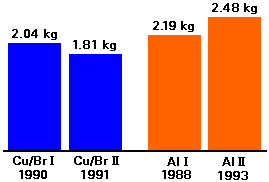 Thermal Performance: 3kW/ °C
Thermal Performance: 3kW/ °C Based on wind tunnel testing on four modern radiators
Figure 4. Copper & Brass Lowers Auto Radiator Weight for Increased Efficiency
Misconception 2:
Copper is more expensive than aluminum, therefore a copper radiator must be more expensive than one made from aluminum.
FALSE!
According to the London Metal Exchange (LME), copper cathode was 37% higher in price than aluminum ingot at the end of 1996 (96 cents and 70 cents per pound respectively - December 30, 1996). The top curve of Figure 5 shows that copper also tends to be more expensive even though the ratio varies over time. But radiators aren't made from copper cathode or aluminum ingot. They are made from fin strip and tube strip.
When you add into the calculation of radiator material costs an index of prices for copper/brass radiator strip and aluminum radiator strip, we get a far different picture. As the bottom curve illustrates, while copper cathode on average has been 42% higher in price over the past 15 years than aluminum ingot, copper/brass strip has been at least 4% lower in cost per pound than aluminum strip.
Cu/Al Price Ratio
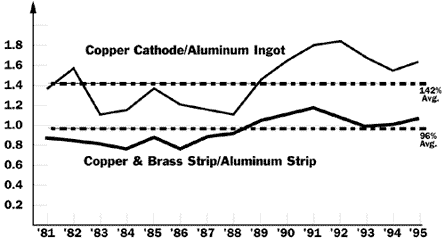 Prices for Copper & Brass Strip Average 4% Less than Aluminum Strip
Prices for Copper & Brass Strip Average 4% Less than Aluminum Strip Figure 5. LOWER COST STRIP Metal and Strip Price Comparisons Show Copper & Brass Competitive with Aluminum
There is a simple explanation for the difference. Aluminum strip costs more to fabricate. Because of the metal's inferior corrosion resistance in the radiator environment, it has to be clad with a sacrificial alloy on the water side in addition to the brazing alloy that is clad on the air side.
Compared to a homogeneous, highly corrosion resistant brass strip (one cohesive piece of metal), the "three-layer" aluminum strip ( Figure 6) is far more costly to produce.
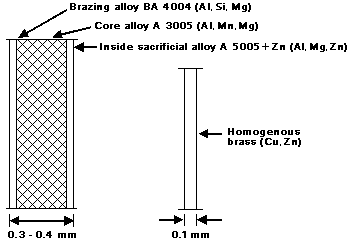 Figure 6. RADIATOR TUBE STRIP
Figure 6. RADIATOR TUBE STRIPMisconception 3:
Aluminum has aggressively penetrated the radiator market, therefore the metal must dominate the world market.
FALSE!
Figures 7, 8 and 9 help sort this out. As indicated in Figure 7, although aluminum penetration of the original equipment (OE) market has been extensive over the past 10 years in Western Europe and North America, it has been very limited in Japan. That is because manufacturers there have continued to upgrade the quality and design of their products and production facilities to meet the technological challenges that followed introduction of the aluminum radiator in world auto markets.
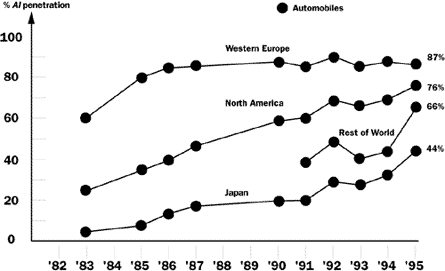 Figure 7. Al PENETRATIONORIGINAL EQUIPMENT (OE) RADIATORS
Figure 7. Al PENETRATIONORIGINAL EQUIPMENT (OE) RADIATORSLooking at the share of market for copper and aluminum in the OE market generally ( Figure 8), we see that aluminum has 68% of new cars, but copper has 55% of new trucks and other commercial vehicles. Combining figures, we see that copper, despite aluminum's growth, has 39% of the total worldwide OE radiator market.
| Cars | Commercial Vehicles | Totals | ||||
|---|---|---|---|---|---|---|
| Region | Cu/Br | Al | Cu/Br | Al | Cu/Br | Al |
| West Europe | 13 | 87 | 28 | 72 | 15 | 85 |
| North America | 24 | 76 | 43 | 57 | 32 | 68 |
| Japan | 56 | 44 | 76 | 24 | 62 | 38 |
| Rest of World | 34 | 66 | 72 | 28 | 47 | 53 |
| Totals | 32% | 68% | 55% | 45% | 39% | 61% |
| Marco | ||||||
In the radiator aftermarket ( Figure 9), the figure for copper grows to 89% and for good reason. When corroded or damaged, aluminum radiators are far more difficult and expensive to repair. In particular, they are prone to coolant-side, pin-hole corrosion. When this occurs, the radiator is irreparable.
| Cars | Commercial Vehicles | Totals | ||||
|---|---|---|---|---|---|---|
| Region | Cu/Br | Al | Cu/Br | Al | Cu/Br | Al |
| West Europe | 92 | 8 | 86 | 14 | 83 | 17 |
| North America | 98 | 2 | 99 | 1 | 98 | 2 |
| Japan | 88 | 12 | 97 | 3 | 91 | 9 |
| Rest of World | 84 | 16 | 82 | 18 | 83 | 17 |
| Totals | 88% | 12% | 91% | 9% | 89% | 11% |
| Marco | ||||||
Lower Cost Radiator Core
When you compare the actual cost of metal for brazed radiators of the same weight ( Figure 10), copper/brass is fully cost competitive with aluminum.
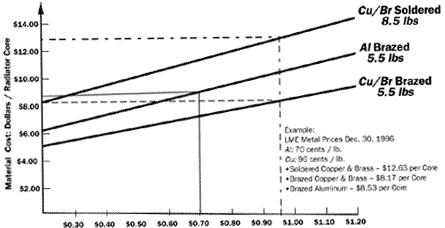 Metal cost: Dollars / lb (LME)
Metal cost: Dollars / lb (LME) 36% Lower With Brazed Copper & Brass
Compared to Soldered Copper & Brass
Figure 10.LOWER COST CORE Material Cost Comparison Shows Copper Fully Competitive With Aluminum
Applying new technologies to its manufacture, the new copper/brass radiator will be 30% - 40% lower in weight compared to a conventional soldered copper/brass radiator - the radiator that most manufacturers and consumers are familiar with - and correspondingly lower in material cost. But this isn't surprising. The recent history of the copper/brass radiator ( Figure 11) has been a continuing evolution to reduced size and lower weight compared to aluminum.
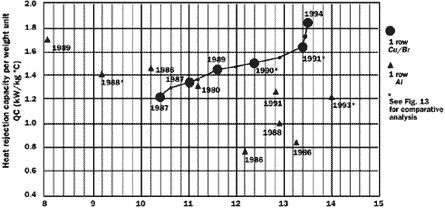 Heat rejection capacity per area unit
Heat rejection capacity per area unit QC (kW / m² °C)
Evolution of Copper & Brass Radiator
Shows Reduced Size and Lower Weight
Figure 11. SMALLER SIZE Copper & Brass Auto Radiators Are More Efficient than Aluminum
Lower Cost Manufacturing
Assessing the various steps in the actual manufacture of copper/brass and aluminum brazed radiators ( Figure 12), the cost competitiveness of copper/brass is substantiated even further when measured against the three principal methods for brazing radiators. Since copper/brass requires fewer steps, it can be manufactured more easily and at substantially less cost. And this comparison doesn't reflect the additional cost of flux that would be required for Nocolok and flux brazing of aluminum.
| Al | Cu & Br | |||
|---|---|---|---|---|
| Operation | Vacuum Brazing | Flux Brazing | Nocolok Brazing | CuproBraze |
| Degreasing before brazing |  |
 |
 |
 |
| Application of flux | - |  |
 |
- |
| Development of halide compounds (pollution) |
- |  |
 |
- |
| Cleaning after brazing | - |  |
- | - |
| After treatment - corrosion inhibitor |
 |
- | - | - |
| 100 | 100 | 80 | 70 | |
Higher Performance
In addition to confirming the lower weight of copper/brass compared to aluminum, recent wind tunnel tests ( Figure 13) again confirm the higher performance of copper/brass radiators compared to aluminum. Besides smaller size, higher performance also leads to greater design flexibility.
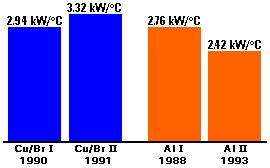 Core Weight: 2 kg
Core Weight: 2 kg Based on wind tunnel testing of four modern radiators
Copper & Brass Auto Radiators Tested
More Efficient than Aluminum Auto Radiators
Figure 13.HIGHER PERFORMANCE Wind Tunnel Testing Shows Copper & Brass Superior to Aluminum at Equal Weight
See radiator specifications in Figure 14.
| Cu/Br I | Cu/Br II | Al I | Al II | |
|---|---|---|---|---|
| Size L x H, mm | 698 x 325 | 597 x 371 | 435 x 670 | 597 x 371 |
| Core Area, m 2 | .227 | .221 | .291 | .221 |
| Fin density, FPI | 22 | 28 | 14 | 20.5 |
| Tube D x W x t, mm | 15 x 1.5 x .11 | 16 x 1.7 x .10 | 21.5 x 2.5 x .33 | 32 x 2 x .40 |
| Fin D x W x t, mm | 16 x 9 x .038 | 17.3 x 7.25 x .025 | 23.0 x 8.5 x .12 | 33.8 x 9 x .090 |
| Heat Performance, kw/°C | 2.80 | 2.94 | 2.69 | 3.10 |
| QC, kw/M 2/°C | 12.35 | 13.30 | 9.25 | 14.02 |
| QC, kw/kg/°C | 1.47 | 1.66 | 1.38 | 1.21 |
| Core weight, kg | 1.90 | 1.77 | 1.96 | 2.56 |
| Pressure drop, Pa (8"/S) | 150 | 225 | 200 | 400 |
A Ten-Year Life!
According to recent tests, summarized in the September 1993 Automotive Engineering, advanced copper/brass radiators will have 10 or more years of service in cars and trucks. The main reason is corrosion resistance - inherent in the metal itself and enhanced by electrophoretic coating ( Figure 15), which covers all the external surfaces, even in the dense inner core of tubes and fins. E-coating utilizes 95% - 99% of paint as opposed to 30% - 70% utilization in conventional spray painting.
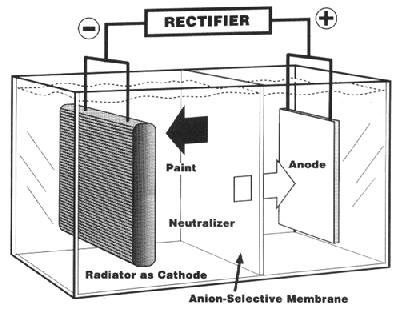 Figure 15. ELECTROPHORETIC COATING BATH
Figure 15. ELECTROPHORETIC COATING BATHIn addition to more efficient paint utilization, E-coating is environmentally cleaner and easily integrated with other radiator production operations.
The overall durability of the copper/brass radiator can be strengthened even further by splitter fin and other innovative designs.
Back to TopRecyclability - Making More of Valuable Metal
In recent years, recycling has become a major issue in the automotive world. Manufacturers, consumers and public officials want to do everything they can to minimize the environmental impact of cars and trucks. They also want to cut manufacturing costs. Finding ways to reuse metal is one way to accomplish these goals.
Among the most common metals, copper is particularly valuable as recycled material. Owing to its high scrap value, it is one of the most recycled metals in the world. According to Metal Statistics, 1981 - 1991, in the U.S. 59% of total copper consumed is recycled versus 37% of total aluminum consumed. The figures for Western Europe are 53% and 25% respectively, and 55% and 31% in Japan.
Of the total European copper scrap, 57% was recycled without refining. Virtually 100% of copper scrap is recyclable. Scrap copper and brass can be remanufactured into brand-new, high-quality radiator materials. Currently, copper radiator scrap in the U.S. sells for 54% of the price of copper cathode (LME, February 4, 1994).
Using these figures as background, we can see that the "third generation" copper/brass radiator will be even more recyclable. Made without lead/tin solder, the copper will be easier to separate. In fact, ease of recycling is a given with copper/brass since a well-established and well-utilized infrastructure for its reclamation has been in place for many years.
Back to TopAdvanced Radiator for Advanced Needs
Today's world is not what it was 10 years ago. Today's motor vehicles demand a radiator that is more efficient, more durable and of higher quality than anything that currently exists. The worldwide copper industry is committed to introducing this radiator in the years ahead.
By bringing the advanced copper/brass radiator into being, the worldwide copper industry will be contributing to the advancement of radiator technology for the cars and trucks of tomorrow.
Back to TopCompetitive Advantages of Copper/Brass Radiators (Versus Aluminum Radiators)
Technical
- High thermal conductivity
- High corrosion resistance
- High tensile yield strength
- Higher melting point
- Lower coefficient of thermal expansion
- Higher modulus of elasticity
- No-flux brazing
- Easy repairability
Commercial
- Lower fabrication cost for tube and header material
- Well-established recycling tradition (infrastructure in place)
- High scrap value
- Well-established aftermarket tradition (infrastructure in place)
- High-quality reputation
